We’ve all experienced, at one point or another, the crushing realization that our work has gone up in smoke. This could be a paper or Excel sheet due tomorrow you haven’t saved, which a never-before-seen error wipes away; it could be losing hours of unsaved progress in a game because of a dumb mistake, or it could be something truly terrifying as your site going down without a proper backup in place. In these cases, you’ll probably hear something along the lines of “always back up your work” or “saving regularly prevents stress” from somebody who’s gone through the same or similar situation before but now knows better.
However, that first loss needs to happen because we rarely learn from other people’s mistakes.
Not to take away from other traumatic situations we’ve mentioned, but a site crashing really does seem to stand above the rest.
Firstly, it’s a big issue – a site consists of so much content, especially if it’s been around for a while (much more than a Word document or Excel sheet). Secondly, your site being down is just the beginning of your troubles because the longer your visitors can’t access it, the more traffic and subsequently revenue (directly or through ads/sponsorships) you’re losing. Finally, if there isn’t a proper backup system to fall back on, there is no telling how the site will look once it’s up and running again – it could mean a massive overhaul, and as we all know, usually people aren’t fond of big changes.
Therefore, it’s easy to see why one of the pillars that hold up a successful site is a quality backup service.
Today, we’ll try to explain what to look for when searching for a backup plugin. After that, we’ll offer three plugin suggestions that are viewed as top options and compare them to make it easier for you to choose one. It’s important to point out that our suggestions will be based on the presumption that your site is running on WordPress since that’s the most common platform.
With that out of the way, let’s start!
What to keep an eye out for
Storage

Probably the first thing that comes to mind when thinking about backing something up is how much available space there will be. The amount of storage space allocated for your site varies wildly from plugin to plugin as well as from tier to tier within a plugins tier hierarchy. It isn’t uncommon for these plugins to have a trial tier that offers all the goodies a complete tier would have, but with a very limited storage plan. This way, you get to see how all the features work without having to guess, but to fully use the plugin for all your content, you’ll still need to commit.
It’s also very important to know how your data is being saved – some plugins offer only local backups, while others add cloud backups as well. If you’re moving around a lot while working and/or work on different machines, cloud backups is something you should insist on in your search for a backup plugin, even if there is an added cost because of the feature. The ability to access your data anytime, anywhere is invaluable and should be treated as such. Alternatively, you can always save your data locally and bring it with you, but that’s simply not as efficient.
When talking about what to aim for regarding storage, it’s really quite easy – more is better. Naturally, you don’t need to go all out if there is a gaping disparity between your real needs and the top option available, but it’s always better to have more space and not need it than need it and not have enough. A blog that is active once or twice a day doesn’t require nearly as much storage as a site that’s saturated with multimedia files – the scale is usually pretty clear; you just need to find your place on it.
Depending on your allocated space, data that’s saved works differently as well. With some plugins, you’ll be able to back up only your core WordPress database, while other plugins offer a complete backup, which essentially includes everything – custom files, posts, pages, plugins, and themes. There will be enough options for you to choose from that make a tier optimal for you most of the time, so there is no need to fret.
Automated backups
Generally speaking, every backup plugin has some sort of automated backup system in place; it has simply become the standard nowadays. However, it’s still an important thing to check for before choosing your preferred option; and additionally, not all automated backup systems are the same.
Just as you would expect, automated backups run on a schedule where a backup of the site (in a predefined form) is made. This can be done once a day, which is most common, or multiple times a day (this is potentially an added feature in more pricey tiers).
Anything less frequent than once a day should be considered a red flag, and that plugin should be avoided.
What’s important from your perspective as the site owner/manager/admin is to know what works for you. Automated backups that are additionally charged, for instance, could put a dent into your budget, and there is a chance you don’t need them at all.
For example, suppose you’re running a cooking blog/site where you post recipes once, maybe twice a day. In that case, anything more frequent than a regular 24-hour backup cycle is usually too much. On the other hand, if you’re running something like a news outlet with dozens of new posts published every day, belonging to several categories, where some of the posts are time-sensitive, multiple daily backups are a good idea even if you’d potentially have to spend a little more money on them.
One-click restore

There have never been more people claiming a part of the web as their own. Even without social media, more than ever, we can see sites and blogs being put up by people often for nothing more than to share their thoughts, views, and experiences.
Thanks to this fact, you can easily deduce that only some of them (probably a very small number) have the knowledge of how a site functions behind the scenes. With its plugins, platforms like WordPress have made it increasingly easy for anybody to build a blog/site even without any coding expertise whatsoever. Therefore, it’s crucial for a backup plugin to enable user-friendly, quick, and easy access to all its features.
The one-click restore feature does exactly what its name suggests – restoring your site with a click of a button, making it ideal for those not versed in all the ins and outs of a site’s technical side. This may be rudimentary for advanced users, but honestly, even though you know how to do something manually, there really isn’t a need for that. This is mostly because of time – let’s break it down.
The reason you would restore a site is often something not working properly. This can range from small things like multimedia files not playing correctly to pages loading slowly and big issues like links not working, or ultimately the site being down entirely. Now, we all know a site being down will cost you revenue, reputability, SEO score, user satisfaction, etc., which is stressful enough by itself but imagine adding to that the need to jump through hoops just to get your site up and running again – it would be a nightmare.
Naturally, you’ll want to figure out where the initial problem began and fix it, but your top priority is getting everything in working order. The one-click restore feature does that without much fuss and is your “get out of jail free card” in the direst of circumstances – look for it in any plugin you’re considering.
Migration
Migration is tricky. Most of the time, when you’re committing to a platform, website builder, hosting service, or something similar, you’ve done your research and are committing long-term.
Because of this, migration features are sometimes neglected or, more precisely, rather low on the list of priorities. However, there might come a time when your best option would be to move on from your current setup. If that time ever does come, you’ll want a backup plugin that supports migration, or you might find yourself with some unforeseen issues to deal with.
The reason why issues will rear their ugly heads is that migration is a complex process.
Looking at it as a glorified copy/paste operation is wrong on so many levels. Whole databases, designations, files, settings, themes, etc., need to be moved, which is extremely taxing to do manually. Some services offer free migration if you’re switching to them (most notably hosting platforms), but this you shouldn’t count on.
Price

Somehow, in the end, everything still revolves around money. If your budget allows, you’ll be able to find a plugin that covers all the features you’re looking for, and if it doesn’t, you’ll need to compromise. There isn’t much to be said here, except reiterate the pointers already given while describing the other features, which can, when talking about cost, all be summed up into – know what you need. If you must cut some things from your wish list, don’t cut randomly; know where you can save.
Usually, storage will be the main thing that sets the price, and if you have a precise idea of what your upper numbers are, you can more easily manipulate the tier system within the plugin.
Another thing to consider is the number of backups that are kept on file. As we’ve mentioned, sometimes going above the default number could cost more, so figure out how many you really need.
There are other factors to consider, and you should consider them, but these two tend to influence the bottom line more than anything else.
Ultimately, if you’re just starting out, there are even great free plugins out there (with the option to upgrade) worth considering, at least until you get your bearings.
Three for the win
As we’ve mentioned in the beginning, we’ll highlight three premier plugins available on the market to give you options while deciding which way to go.
Let’s first take a look at each of them individually.
UpdraftPlus
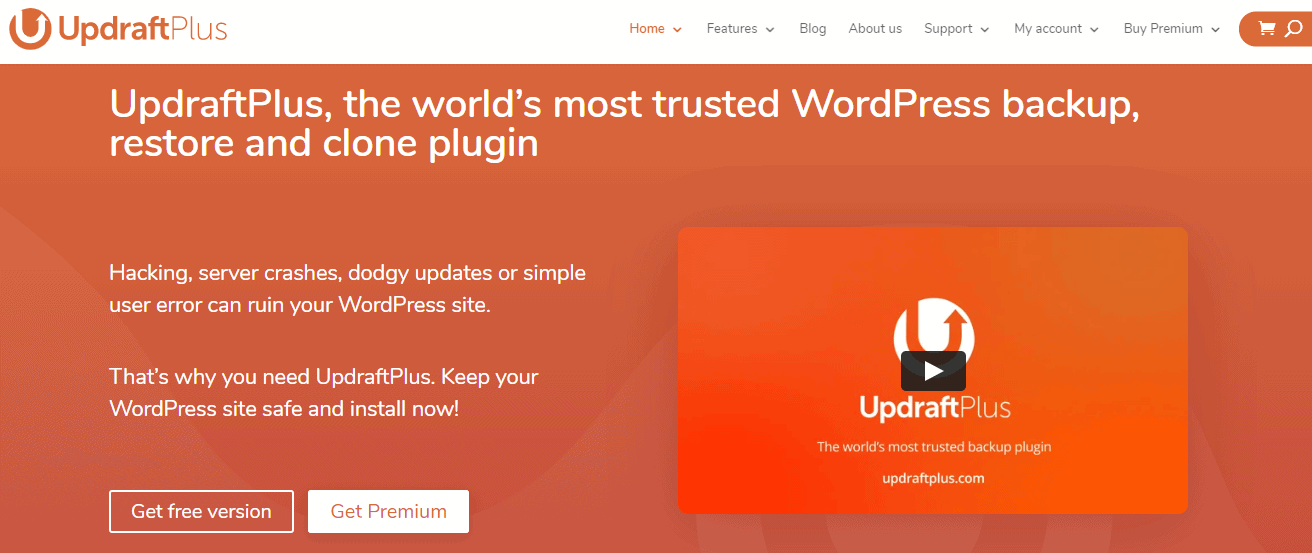
If you went on your own and searched for backup plugins for WordPress, you’ve undoubtedly found UpdraftPlus among them because it’s the most popular backup plugin around (more than 2 million sites use it). One of the main reasons it’s so popular is, without a doubt, its user interface, which is easy to figure out and simple to master. From the provided dashboard, you can even manage more than one site, eliminating the need to switch between them every time you want to check something.
Backups can be scheduled, and the work is done in the background even if you’re actively working on your site (though it’s suggested that you schedule backups for when the backend is idle).
There is no limit to the number of backups you can create, and a schedule can be set even for hourly backups. Additionally, if you make large changes that warrant an immediate backup, you can do one manually at any point.
It’s definitely worth highlighting that all these backups share the one-click restore feature, which we’ve already advised you to look for in your preferred choice of plugin.

All these backups can be stored remotely, using services such as Google Drive, Dropbox, or Microsoft OneDrive, in addition to having copies on hard drives, which are still the most trusted among site managers.
The great thing about the backups made with this plugin is that everything is covered, from the core WordPress files to all your content and uploaded files, as well as plugins, themes, and settings to go with them. Think of your site as an image; UpdraftPlus makes a perfect copy of that image and stores it, so when you need it, you won’t miss a beat.
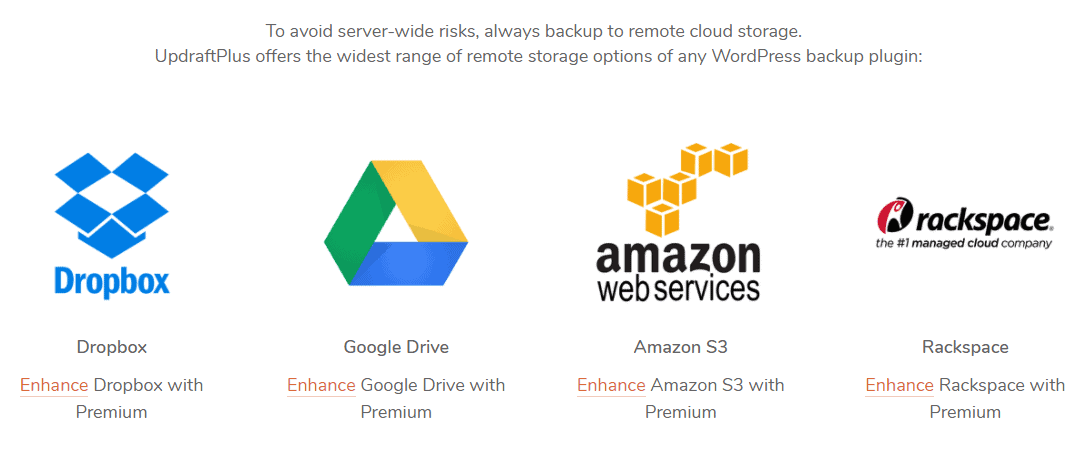
The features up until now haven’t been out of the ordinary. Pretty much all premium solutions out there offer the same things. What’s interesting about the way UpdraftPlus backs up your site is file organization. Your site is broken down into various elements – database, plugins, themes, uploads, etc. that are backed up separately from each other. This means that instead of one giant file where everything is bunched up together, you’ll get multiple sets that are categorized and therefore much easier to go through.
The more content you have, the more grateful you’ll be for this system. Just imagine what it would look like to have a five-year-old site compressed in just one folder – you wouldn’t know where to begin if you ever needed to go through the files.
As a top option on the market, it’s no surprise that UpdraftPlus offers advanced features like migration support and site cloning. We’ve already mentioned these as something that is rather low on your list of priorities, but long-term planning requires you to factor them in when making your decision.
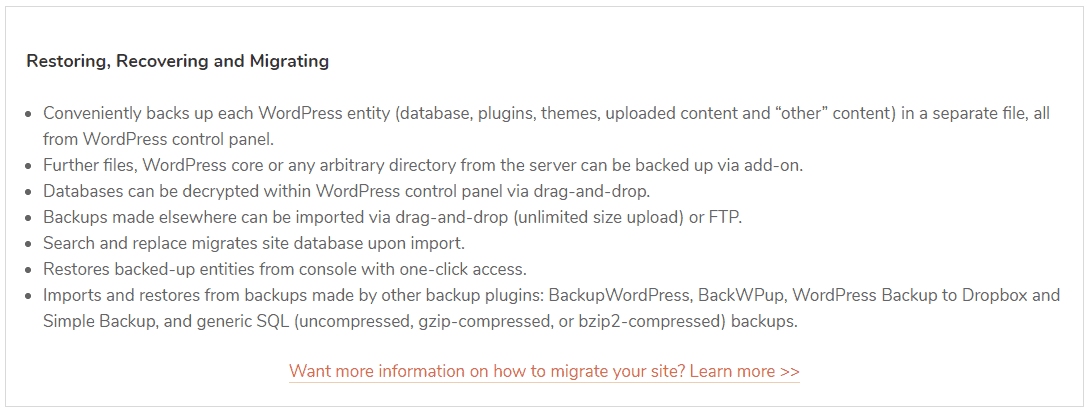
To finalize the UpdraftPlus section, we need to point out that while the plugin boasts a truly impressive number and variety of features, most of them are included in the plugin’s premium version (advanced scheduling, multisite management, migration, etc.).
Namely, you can get UpdraftPlus for free, and not even as a trial version, but an actual full-blown plugin you can use indefinitely. The downside is that the features included are limited, with the more advanced ones requiring you to get an upgrade. This shouldn’t be seen as a negative because you’ll be able to get firsthand experience with the plugin, after which you have the option to commit to the premium version or switch to another solution.
WPvivid
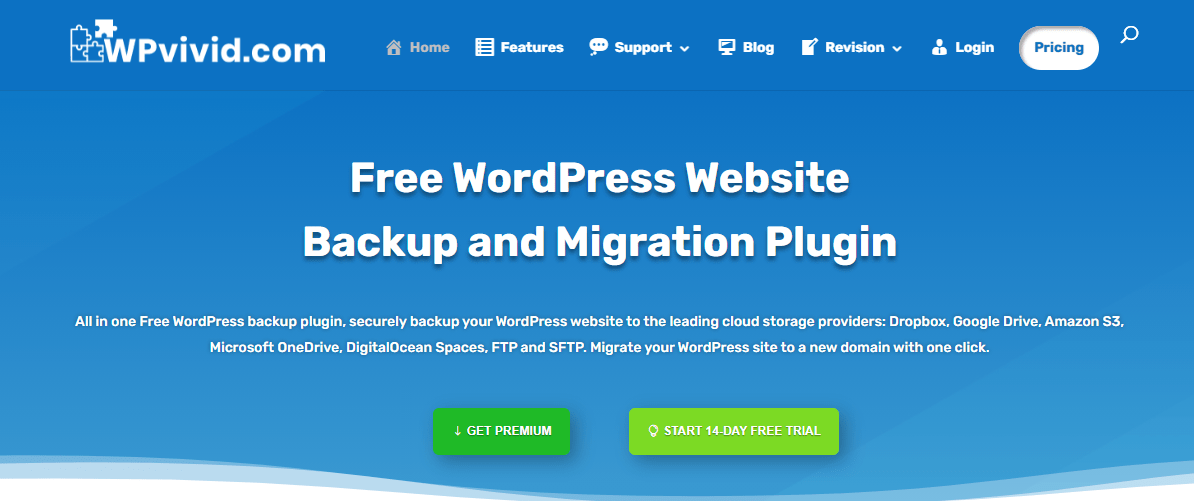
WPvivid might not be as popular as UpdraftPlus, but that doesn’t mean it’s inferior. As you would expect, because of its wide target user base, WPvivid is really easy to set up; there isn’t much difference between this and any other plugin you’d use. The moment it’s operational, you can back up your work.
All the features that have become unwritten industry standards are present – creating schedules for automatic backups and the ability to make manual ones, one-click restore, local and cloud storage options (most notably again, Dropbox, Google Drive, Microsoft OneDrive, etc.), and so on. There is no need to waste time on those, and instead, we’ll shift our attention to the features that make WPvivid unique from other solutions out there.

WPvivid offers you a much greater dose of control over your files than you would find elsewhere. You’ll be able to set the size limits of files you’re backing up. These function as a size cap, and anything that’s over it won’t be included in the backup.
You’re probably wondering why anyone would limit their files, so they are excluded from the backup, but consider that storage space can be limited (cloud storage, for instance). If storage space is limited and you have a couple of multimedia files that prevent successful backups, just exclude them and let the rest of the site go through the process.
Additionally, you can save the aforementioned files locally so they are included in the site if ever a restore operation is performed. It’s worth noting that the plugin itself doesn’t have a limit for the backup size; the only limitations could be put in place by your hosting service, cloud storage, etc.

While we’re on the subject of size, let’s look at the backup splitting feature. It allows you to split your backup into parts for easier handling and, again, if you have limited storage. Note that this splitting won’t be the same as UpdraftPlus’s, where elements are sectioned off into sets. Instead, this splitting entails just breaking up a big backup file into smaller ones without any choice as to what file will end up in what part.
To restore the split backup, you’ll still need access to all the parts; partial restoring isn’t an option.

By far, the most interesting thing about WPvivid is its migration features. They’re set up so that it’s easy to migrate your site, be it to a new server, domain, or host. It’s done with just a simple click, if you can believe it. Note that you will have to install WPvivid on the destination server for the auto-migration to be successful. Furthermore, you’ll be able to transfer your databases to a staging site for testing. Not a lot of other plugins offer these features, and the best part is that the auto-migration is included in the free version.
Once more, we’ll issue the familiar disclaimer – our thoughts on the WPvivid plugin are based on the Pro version that includes all the features we’ve mentioned. The free version holds all the core features and the auto-migration, which sets it apart from other plugins that don’t offer such an advanced feature for free. So, feel free to try out the waters with the free version before upgrading to the Pro one.
BackupGuard
At last, we come to our final competitor in this backup plugin showdown – BackupGuard. This plugin is relatively new on the market, making it somewhat unknown compared to the other ones. Feature-wise, however, it’s not lagging behind anybody.
Once more, we find a plugin that’s aiming for the widest audience possible with its simple interface that lets you create backups with just one click. Within the dashboard, you’ll get access to all your backups spread across all your storage locations. The focus of BackupGuard is cloud storage. It’s compatible with all the major services and also offers an interesting feature for cloud backups.
Namely, you’ll have an interface through which you can pick the services you want your backups to be stored on – everything is on the same page, all you need to do is tick the on/off button, and your backup is saved in multiple places at once, in a flash. So if you’re looking for extra security, i.e., storing backups in multiple places, this feature will make it very easy.
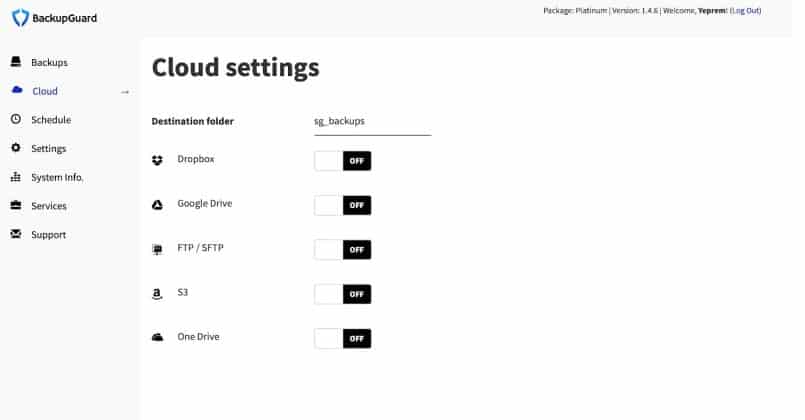
Making multiple backups at once also comes in handy when you combine it with the scheduler; let’s explain. The plugin allows you to separate what data you’re backing up, thus creating custom backup schemes, where you select your whole site, just the database, etc. That coupled with multiple backup schedule setups means you have a full-proof backup plan.
For example, you can create a schedule for backing up your whole site daily (to one or multiple locations) but also an hourly backup just of your database (to one or multiple locations).
Finally, to cover everything, you can set up a monthly backup schedule in a location you’re not using for the other backups.
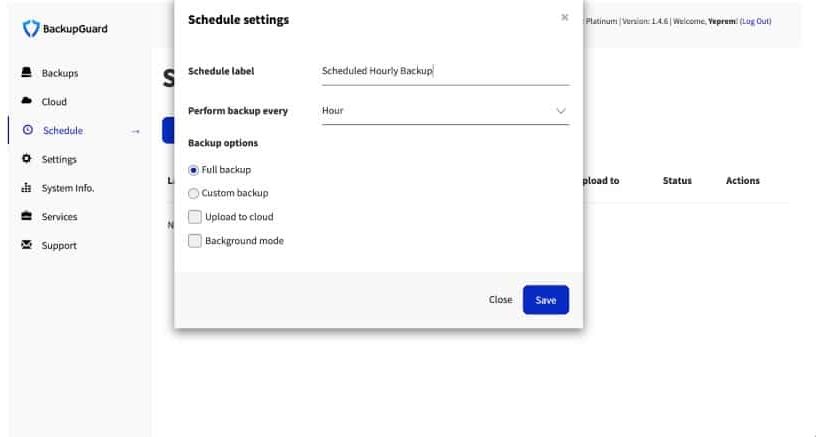
By using multiple schedules and multiple storage locations, you have backups upon backups, which will secure your site in the worst of situations.
As you would expect, all these backups are ready to be restored with just one simple click, adhering to the overall standard.
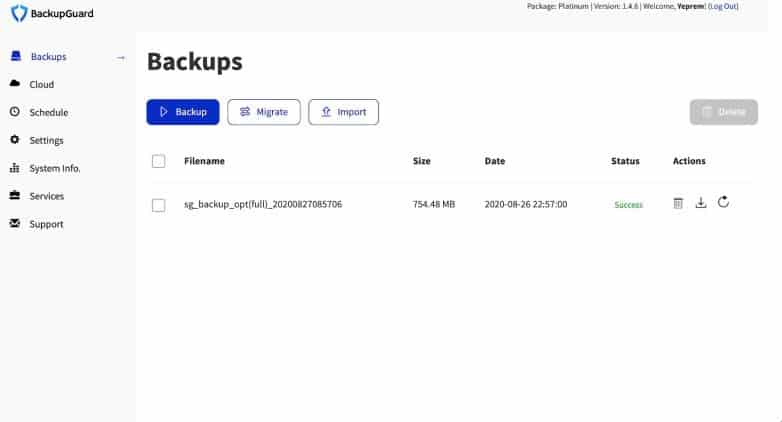
Migration is another thing that has been remade into a simplified operation you’ll get the hang of very quickly. Upon making a backup, all that’s needed from your end is to install the plugin on the destination server, download and extract the data from the previously made backup, and once that is done, your site is up and running on the new server/domain.
Over time, as the number of backups grows, you might consider letting go of the older ones. Thankfully, you won’t have to delete these manually; instead, you can set a maximum number of backups you want to keep, and when that limit is reached, the older ones are automatically replaced with new ones.
As we did for the previous two plugins, we need to point out that all of these features are available in the Pro version, while some are excluded from the free version you can obtain through the WordPress repository.
While the free version will give you a good idea of what to expect, to fully maximize the plugin’s potential, you’ll want to upgrade to the Pro version.
Let them fight!

You’re now familiar with all the features and the little nuances that separate the three plugins we’ve highlighted, but let’s make things even clearer.
Since we devoted the time to emphasize the most important things to look for in a backup plugin, it’s only fair to stack the competitors against one another to see which one will reign supreme. Keep in mind that all of these are top-tier options; therefore, there’ll be many more similarities than differences between them. While there is a winner, you’ll be satisfied with each of the solutions we’ve presented.
Storage
Storage shouldn’t be viewed from the perspective of how much space is provided by a certain plugin because that data is redundant. You’ll save your backups locally and/or on the cloud (every plugin is connected to the same cloud storage services), and in neither of these options is the allocated storage space determined by the plugin you’re using. Instead, let’s look at how your data is stored.
The easiest way to see it is if you image a closet.
BackupGuard will take all your data, bunch it up and throw it into the closet – it’s all there, nothing is lost, and once you restore it, it’s as easy to use as before the restore.
WPvivid will, if you so choose, install shelves, but there will be no sorting; data will be randomly placed on the shelves, and you won’t know where anything is until you restore it. Alternatively, you can opt not to use the “shelves” and just bunch everything together as with the previous example.
Finally, we come to UpdraftPlus, which will organize your closet with shelves and drawers, sorting all your data so you can store and access each set individually. Because of this unique feature, UpdraftPlus gets the win.
Winner: UpdraftPlus
Automated backups

We’ve mentioned it a few times during the article – automated backups are a standard nowadays. As such, all of the plugins have them, even in their free versions. Scheduling these backups is also expansive, with the option for hourly backups onwards.
Simply because all of our plugins offer the same thing, there is no winner in this section.
Winner: Draw
One-click restore
Just like automated backups, all the plugins offer a one-click restore feature. It’s actually becoming exceedingly hard to find a backup solution that doesn’t offer this simplified restore feature.
Because this is such a common feature, all the plugins have it as a core function, i.e., it’s available in their free versions. So, we couldn’t make a distinction because there isn’t any.
Winner: Draw
Migration

Migration is considered for two main purposes. It’s for moving a staging site to a server and going live, or it’s a long-term failsafe if you want to switch servers or domains in the future.
All three options offer relatively easy migration within a few clicks, with the only prerequisite of having the plugin installed on the destination site/server.
Only WPvivid offers a migration solution in its free version. That, along with the simplified interface of the auto-migration section, is enough to take the win.
Winner: WPvivid
Price
Firstly, it’s fair to mention that every plugin has a free version you can get from the WordPress repository and potentially use indefinitely. However, features will be limited, so for the best performance, we advise going for one of the paid tiers.
As the most recently released plugin that’s still building its market, BackupGuard is the most affordable, followed by WPvivid, and UpdraftPlus – the most expensive option of the three.
Since all of them share the core features you need for successful backups, with expanded additional features being just a bonus but not really necessary to get the job done, we’ll go with BackupGuard.
Winner: BackupGuard
Special features

Every plugin covers the core features we expect from a top-tier backup solution, but each of them also offers some nuanced additions to these. Either big or small, these extra features aim to make their respective plugins unique from a user’s point of view.
With the multisite dashboard and the unique way backups are sorted, UpdraftPlus rises above the competition in additional unorthodox features. Comparing these to the slightly advanced migration options, file splitting, and file size caps of WPvivid, as well as BackupGuard’s expanded scheduler and cloud storage activation page, it really wasn’t such a tough choice.
Winner: UpdraftPlus
The fact that there isn’t a clear-cut winner emphasizes that all three plugins have their merits and should be strongly considered. Having said that, UpdraftPlus stands out as the premier option here, aimed for larger sites and those with a somewhat bigger budget; WPvivid is the overall “middle” solution that works well for startups and those already established; BackupGuard is the most affordable and its target audience are those just starting out. Still, it has the potential to grow as they do.
FAQ

For easier navigation, we’ll list a few of the most common questions you might have about backup plugins, so you don’t have to lose time going through the entire article to find what you’re looking for. If you don’t find your answer in this section, then try browsing through the article, it may be a long read, but you’ll surely get the information you came for.
Do I really need a backup plugin? Isn’t the default WordPress backup feature enough?
In general, the default WordPress backup feature should be enough. However, your site might be in such a state that even its backup fails, and that’s where the importance of backups that don’t rely on WordPress comes in. You can have local backups or cloud backups that will always be safe no matter what happens with the platform.
Is it better to create local backups or use cloud storage?
The wisest thing is to use both, but not necessarily at the same intervals. Local backups on your PC/laptop could be lost if anything happens to the hardware, and those on external drives are gone if the drive is lost or damaged. Cloud storage is better because only under unforeseen catastrophic circumstances can your data be lost, but you might still stumble upon a situation where you can’t access it (bad internet connection, for example).
So, depending on if your work is stationary or the exact opposite, you could make alternating schedules – daily local backups with weekly cloud backups or vice versa, for maximum effect.
My site is on a budget. Can I get a worthwhile backup plugin for free?
Yes, while you’ll get much more with their premium versions, all the suggested plugins come with a free version as well. Because each of them limits different features, you should look into what features are most important to you (WPvivid, for example, offers migration in its free version) and find your optimal free plugin based on your preferences.
I manage multiple sites; do I have to install the plugin on each one?
Yes, you’ll have to install the plugin on each one to work properly. However, UpdraftPlus will have the added bonus of managing all your sites through the accompanying dashboard. Note that this is a premium feature, but one that makes juggling multiple sites much easier.
Should I use multiple backup plugins just to be safe?
You could, but there is no need. Because the plugins act as a mediator between your data and the storage location, having more of them doesn’t serve a purpose since they all offer the same things – local backups and cloud storage. If you want to be extra safe, make more backups, whether locally or on several cloud storage services.
Do backup plugins replace the need for backups done by hosting services?
The short answer is yes; you can get by just with backup plugins and not miss a step. However, we would advise finding a hosting service that does backups. Once you’re committed to a service, they’re then obligated to back up your site, releasing you from the burden of having to worry about that. Additionally, you can then also use a plugin for your personal backups.
Final thoughts
Backups are your safety net when managing a site. If it ever comes to a point where you have to crash everything, they’re there so you can get on your feet quickly and never miss a beat.
The old saying goes – “Hope for the best, prepare for the worst”.
Outside of testing sites, nobody really wants to be in a situation where you have to restore your site through a backup because it means something has gone wrong. However, if you deny yourself that option, you’ll be in a much worse situation, with possibly years of work gone forever.
So, do yourself a favor, learn from others’ mistakes, and use one of the above-mentioned plugins to back up your site; your future self will be very glad you did.

Matej…I’ve been using WPReset for awhile now, but haven’t read your blog until today. I have to say that your blog posts are some of the most useful and best-written I’ve seen. Great work…thank you.
Thank you for this passionately detailed comparison.
I am using UpdraftPlus and am extremely satisfied with its features.
However, sometimes it takes up a lot of CPU resources while creating a backup.
Maybe it’s the problem of every plugin with similar functionality.
I will test BackupGuard and WPvivd to see if this improves